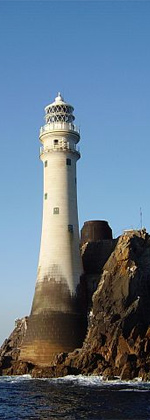
John Rennie FRSE FRS was a Scottish civil engineer who designed many bridges, canals, docks and warehouses, and a pioneer in the use of structural cast-iron.

Fastnet Lighthouse is a 54m high lighthouse situated on the remote Fastnet Rock in the Atlantic Ocean. It is the most southerly point of Ireland and lies 6.5 kilometres (4.0 mi) southwest of Cape Clear Island and 13 kilometres (8.1 mi) from County Cork on the Irish mainland. The current lighthouse is the second to be built on the rock and is the tallest in Ireland.

The Baily Lighthouse is a lighthouse on the southeastern part of Howth Head in County Dublin, Ireland. It is maintained by the Commissioners of Irish Lights.
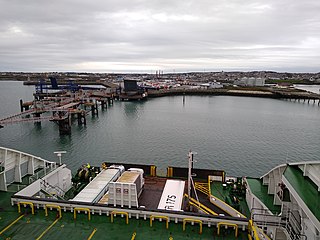
Salt Island is joined to Holy Island, Anglesey, in North Wales. It is a natural provider of shelter for the town's Old Harbour from the Irish Sea and is part of the Port of Holyhead.

RMS Leinster was an Irish ship operated by the City of Dublin Steam Packet Company. She served as the Kingstown-Holyhead mailboat until she was torpedoed and sunk by the German submarine UB-123, which was under the command of Oberleutnant zur See Robert Ramm, on 10 October 1918, while bound for Holyhead. She sank just outside Dublin Bay at a point 4 nautical miles (7.4 km) east of the Kish light.

The National Maritime Museum of Ireland opened in 1978 in the former Mariners' Church in Moran Park, located between the seafront and the centre of Dún Laoghaire town, southeast of Dublin city. President Michael D. Higgins officially re-opened the museum in 2012.

The City of Dublin Steam Packet Company was a shipping line established in 1823. It served cross-channel routes between Britain and Ireland for over a century. For 70 of those years it transported the mail. It was 'wound-up' by a select committee of the House of Lords in 1922 and finally liquidated in 1930.

The Hook Lighthouse is a building situated on Hook Head at the tip of the Hook Peninsula in County Wexford, in Ireland. It is one of the oldest lighthouses in the world and the second oldest operating lighthouse in the world, after the Tower of Hercules in Spain. It is operated by the Commissioners of Irish Lights, the Irish Lighthouse Authority, it marks the eastern entrance to Waterford Harbour. The current structure has stood for 848 years as of 2020.

The Kish Bank is a shallow sand bank about seven miles (11 km) off the coast of Dublin, in Ireland. It is marked by the Kish Lighthouse, a landmark well known to sailors and ferry passengers passing through Dublin Bay and Dún Laoghaire harbour.

Donaghadee Lighthouse is a lighthouse in Donaghadee County Down, Northern Ireland. Donaghadee is probably best known for its lighthouse and harbour. There has been a haven for ships at Donaghadee for centuries, and there has also existed a harbour since at least the 17th century.
Rochdale and Prince of Wales were two troop ships that sank in Dublin Bay in 1807.

Dún Laoghaire Harbour and Carlisle Pier were constructed in the nineteenth century for the purposes of sheltering ships and accommodating the mailboat which sailed between Dún Laoghaire and Holyhead. The nearby settlement of Dún Laoghaire has also previously been known as Kingstown and also as Dun Leary. Carlisle Pier has been known previously as Kingston Pier and the Mailboat Pier.

The Port of Holyhead is a commercial and ferry port in Anglesey, Wales, handling more than 2 million passengers each year. It covers an area of 240 hectares, and is operated by Stena Line Ports Ltd. The port is the principal link for crossings from north Wales and central and northern England to Ireland. The port is partly on Holy Island and partly on Salt Island. It is made up of the Inner Harbour, the Outer Harbour and the New Harbour, all sheltered by the Holyhead Breakwater which, at 2.7 kilometres, is the longest in the UK.
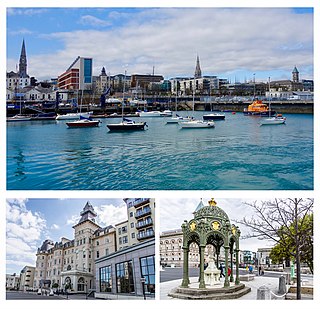
Dún Laoghaire is a suburban coastal town in the traditional county of Dublin in Ireland. It is the county town of Dún Laoghaire–Rathdown, one of the three authorities that replaced the old Dublin County Council in 1994.

Holyhead Breakwater is situated at the north-western end of Holyhead on the island of Anglesey in North Wales. The Victorian structure, which is 1.7 miles (2.7 km) long, is the longest breakwater in the United Kingdom. The breakwater, which is accessible in good weather, has a promenade on top which leads out to the Holyhead Breakwater Lighthouse.
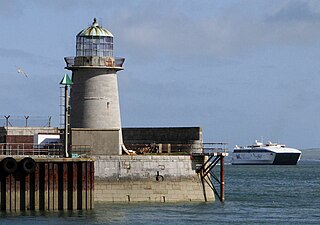
Holyhead Mail Pier or Admiralty Pier Lighthouse on Salt Island, Anglesey, is an inactive lighthouse which was designed by the civil engineer John Rennie in 1821. It was built in the early 19th century to help guide shipping into the newly constructed harbour, now known as the Port of Holyhead, which acted as the terminus for the packet service between England and Ireland. It is probably the second oldest lighthouse in Wales, after Point of Ayr Lighthouse and is the last of a series of three lighthouses located on Salt Island.

Admiralty Arch, in Holyhead, Anglesey, was built in 1824 to mark the end of Thomas Telford's Holyhead road. The arch was designed by Thomas Harrison and its main purpose was to commemorate the visit of King George IV of the United Kingdom in August 1821. The King arrived in Holyhead on the royal yacht Royal George on the 7 August, continuing to Plas Newydd where he stopped overnight. He returned the next day to his yacht, but due to poor weather his departure was delayed and the decision was made to transfer to the steam packet Lightning which conveyed him on the 12 August to Howth, near Dublin for his state visit to Ireland. The change to the packet boat was met with widespread approval.

The Inisheer, Inis Oírr or Fardurris Point Lighthouse, is an active 19th century lighthouse located on the island of Inisheer, the smallest of the Aran Islands, in County Galway, Ireland. It marks the south-eastern entrance to Galway bay and the port of Galway known as the South Sound, with a red sector of the light marking the Finnis Rock. The Eeragh Lighthouse which marks the North Sound entrance to the bay on the north-western side of the islands, was also constructed at the same time. Inisheer and Eeragh both became operational in 1857.

Eeragh Lighthouse is an active lighthouse located on Rock Island, one of the Brannock Islands, part of the Aran Islands archipelago in County Galway, Ireland. It marks the north-western entrance to Galway Bay and the port of Galway known as the North Sound. Due to its location it is also known as the Aran North Lighthouse. The lighthouse on Inisheer at the south-eastern end of the islands was also constructed at the same time. Eeragh and Inisheer both became operational in 1857.
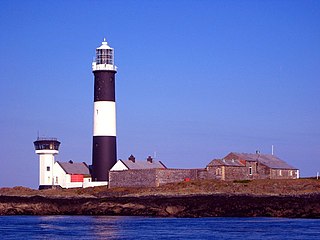
Mew Island Lighthouse is an active lighthouse within the Copeland Islands of County Down in Northern Ireland. The current 19th-century tower is the most recent in a series of lighthouses that have been built in the islands, which have helped to guide shipping around the archipelago and into Belfast Lough.























